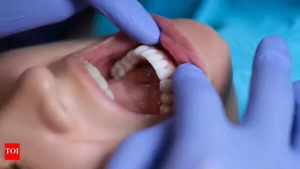Prediabetes is a condition characterized by higher-than-normal blood sugar levels, though not yet high enough to be classified as diabetes. The good news is, early detection offers a high chance of reversibility. With appropriate dietary adjustments and regular exercise, individuals can often return to healthy blood sugar levels within months. While a blood test remains the definitive diagnostic tool, your body often provides subtle clues that blood sugar levels are elevated, prompting the need for medical evaluation. Here are five such indicators:

Increased thirst is frequently an initial indication of elevated blood sugar. When blood sugar spikes, the kidneys are forced to work overtime to filter out the excess glucose through increased urine production. This process can lead to dehydration, creating a vicious cycle where persistent thirst remains even with regular fluid intake. If you observe a noticeable increase in thirst and more frequent trips to the bathroom, it could be a sign of rising blood sugar levels.
Feeling unusually tired, even after adequate rest, can be another warning sign. High blood sugar can disrupt the body's ability to effectively utilize glucose for energy. When cells don't receive sufficient glucose, the result is feelings of weakness and fatigue.

This type of fatigue differs from normal tiredness in its persistence, remaining even after rest. Difficulty concentrating and maintaining alertness throughout the day may also be present. If you experience unrelenting fatigue, including daytime sleepiness, medical evaluation is advised.
Prediabetes can manifest on the skin, with the appearance of dark, thick, and velvety patches. These patches typically appear on the back of the neck, under the arms, or around the groin, a condition known as acanthosis nigricans.

These skin changes are often attributed to elevated insulin levels in the blood, a common characteristic of prediabetes. The sudden or worsening development of these patches warrants medical attention, as it may signal the body's struggle to regulate blood sugar.
High blood sugar can impair the body's natural healing processes. If minor cuts, scrapes, or bruises seem to take an extended period to heal, it could indicate prediabetes. Elevated blood sugar compromises the immune system and can reduce blood flow to the skin, hindering healing and increasing the risk of infection. Prolonged wound healing should be evaluated by a healthcare professional.
Individuals with prediabetes often experience more frequent hunger, even shortly after meals. This occurs because the body's cells aren't efficiently receiving glucose for energy. The brain then signals the need for more food intake, even when the individual isn't truly hungry.
This heightened hunger can contribute to overeating and weight gain, further complicating blood sugar control. Persistent hunger or intense cravings for sugary and starchy foods may be indicative of an underlying issue.
Newer articles
Older articles
 Bezos-Backed Methane-Tracking Satellite Mission Ends Abruptly After Loss of Contact
Bezos-Backed Methane-Tracking Satellite Mission Ends Abruptly After Loss of Contact
 Africa's Rift Valley: Mantle Upwelling Fuels Volcanic Activity, Foretelling New Ocean Birth
Africa's Rift Valley: Mantle Upwelling Fuels Volcanic Activity, Foretelling New Ocean Birth
 7 Proven Habits to Nail Your Next Job Interview: Project Confidence and Authenticity
7 Proven Habits to Nail Your Next Job Interview: Project Confidence and Authenticity
 Smith Targets Test Return After Innovative Baseball Cage Rehab in New York
Smith Targets Test Return After Innovative Baseball Cage Rehab in New York
 5 Subtle Signs of Prediabetes You Shouldn't Ignore
5 Subtle Signs of Prediabetes You Shouldn't Ignore
 Oral Cancer: Know the Warning Signs, Risk Factors, and Why Early Detection is Key to Survival
Oral Cancer: Know the Warning Signs, Risk Factors, and Why Early Detection is Key to Survival
 Hair Oil vs. Serum: Which Elixir is Right for Your Hair Type? A Comprehensive Guide
Hair Oil vs. Serum: Which Elixir is Right for Your Hair Type? A Comprehensive Guide
 Blackcaps and White Ferns Face Packed Home Summer Against Cricket Heavyweights
Blackcaps and White Ferns Face Packed Home Summer Against Cricket Heavyweights
 Gambhir Defends India's Tailenders After Headingley Collapse; Cites Dropped Catches as Key Factor in Test Loss
Gambhir Defends India's Tailenders After Headingley Collapse; Cites Dropped Catches as Key Factor in Test Loss
 England Captain Stokes Lauds Duckett and Crawley for Blistering Start in Record Chase Against India
England Captain Stokes Lauds Duckett and Crawley for Blistering Start in Record Chase Against India